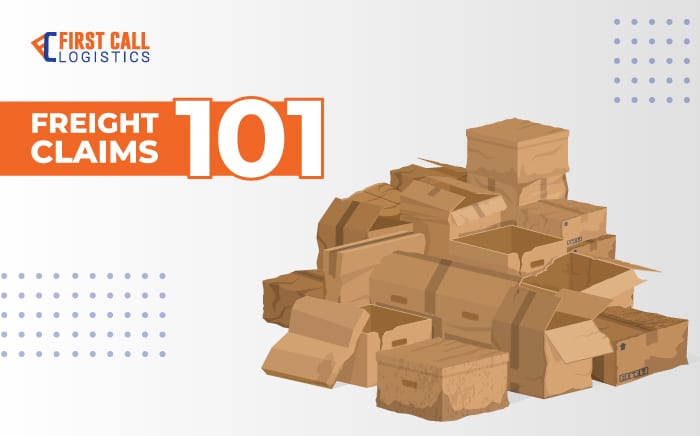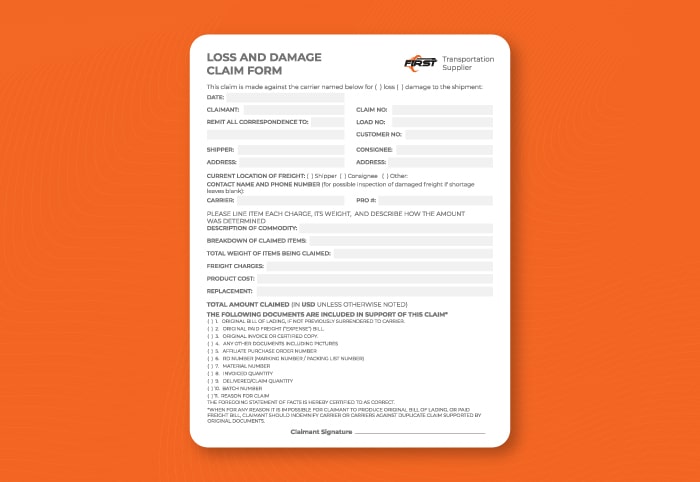A Complete Guide to Freight Claims

The business of cargo transport isn’t without its perils. While certain risks to a shipment’s integrity can be mitigated (don’t miss our resources on strategic packaging and route planning), shippers reserve the right to seek financial compensation for lost, stolen or damaged freight by filing a claim.
Let’s take a closer look at freight claims, including how to accurately categorize and file your claim and common reasons a claim may be denied.
Just the Basics: Freight Claims and Claim Exceptions
The burden of proof is on shippers to prove a carrier is at fault for lost or spoiled goods when filing a claim. Claims can only be validated in cases where freight is retrieved and loaded by the carrier in satisfactory condition, demonstrably damaged (or absent) upon delivery and assessed for damage with an accurate monetary figure.
If a claim is validated, the carrier is held liable and legally obligated to cover the claim. However, in certain cases carriers can claim an exemption under the Carmack Amendment (the definitive legal document detailing duties and liabilities in regard to U.S. cargo loss), absolving them from liability. These exemptions encompass only the following extreme scenarios for which carriers cannot be reasonably expected to prepare:
- Acts of Public Authority: Unpreventable government actions such as embargoes or recalls.
- Acts of Default of Shipper: Demonstrable shipper negligence in regard to packaging, loading and securing goods.
- Acts of War: Damage incurred by hostile forces, including terror attacks. Does not include organized crime.
- Acts of God: Damage due to a sudden, unavoidable natural disaster or physical anomaly. Does not apply to natural events that can be predicted and reasonably prepared for, such as severe weather.
- Inherent Vice or Nature of the Goods Transported: Damage caused to goods while in transit due to the nature of the product (unpreventable rust, spoilage or decay).
Even with detailed filing guidelines laid out by the FMCSA, extensive liability laws and the well-defined exemptions above, there remains plenty of legal gray area in which shippers and carriers often find themselves entangled. Lengthy claims battles aren’t uncommon, making clear freight visibility and bookkeeping practices extremely valuable for shippers seeking compensation for damaged loads.
Common Claim Types
Official legal jargon states the shipper must be “made whole” upon filing a valid claim. Generally, carriers will make shippers “whole” by either replacing the goods in question or offering a reimbursement — so long as the claim is deemed legitimate.
Freight claims and liability exceptions are evaluated on a case-by-case basis to determine whether any loss or damage was genuinely unpreventable or the result of carrier negligence — carriers aren’t keen on refunding shippers for delivery failures beyond their control. Shippers hoping to recoup their losses through a valid freight claim must provide evidence (and meticulous documentation) for at least one of the following:
- Damage: Goods delivered in a damaged state, to the extent they have lost their value.
- Shortage: Goods delivered in an incomplete state (items listed on the BoL missing from the shipment).
- Concealed Damage or Shortage: Previously undetected product damage or shortage discovered after the Proof of Delivery (POD) is signed.
- Loss: Shipments lost or not delivered well beyond the delivery date.
- Carrier Accident: Goods damaged due to a preventable transportation accident.
- Contamination: Goods unspoiled at the time of loading but tainted by environmental contaminants before reaching the destination.
- Refused: Goods brought to delivery point but denied by recipient without justifiable cause.
Freight Insurance vs. Liability Limits
Carrier liability limits are determined by a shipment’s commodity classification, dimensions, condition and packaging. Notably, a liability limit is not the same as insurance, is not based on the cargo’s precise value and in many cases will not cover the freight’s full value.
These limits provide carriers a measure of protection by capping their maximum financial responsibility for a given shipment.
Freight insurance is a broader protection plan provided by a third party, and is based on the declared value* of goods being shipped. If freight is damaged or lost in transit, shippers can file a claim, pay their contractually agreed-upon premium and receive compensation — regardless of where or how their goods were damaged (so long as it occurred in transit).
Freight insurance frees shippers and carriers from the need to prove which party is at fault, and can be used to cover a shipment’s total value.
*Remember, shippers can’t profit from freight claims; freight purchased at wholesale prices won’t be reimbursed at retail value. That’s called insurance fraud.
How to File a Freight Claim
Step 1: Carefully inspect freight upon arrival before signing the POD.
Proof of Delivery (POD) functions as a detailed receipt for delivered cargo; it lists the number and condition of all items delivered and (when signed) represents the closure of a shipper and carrier agreement.
If damage is immediately apparent, the POD can be signed “for damage” upon reception of faulty goods, noting clearly which pieces of cargo arrived in a damaged state (or failed to arrive at all) and supplying photographic evidence of any discrepancies between the load and the Bill of Lading.
Otherwise, a signed POD confirms goods have been delivered without incident and the carrier is essentially in the clear — making a concealed damage or shortage claim more difficult to validate after the fact.
Considering carrier fault grows exponentially more difficult to prove as time passes, claims ought to be filed as soon as damage is discovered. Though Carmack legally allows shippers up to nine months to submit concealed damage claims, individual transportation contracts often shorten this timeframe considerably; it’s typical for carriers to require any concealed damage claim be filed within five days of delivery.
Step 2: Save what you can.
All parties are responsible for mitigating product loss or damage and salvaging what they can to avoid a total loss. Failure to at least attempt saving the freight can give a carrier grounds to deny your claim. If the damage is extensive enough, a written explanation of why the items are not repairable must be provided. Take care not to discard the damaged cargo until the file has been resolved — the freight itself is evidence of the claim, and you may be required to return it.
Step 3: File a claims form with supporting documentation.
While the filing process isn’t entirely standardized, every carrier has a claims form designed to collect basic shipment information. Successful claims need supporting evidence to receive validation, which generally includes some combination of the following:
- Shipment identification
- Clearly stated type of loss or damage
- Claim amount
- Expectations for payment
- Copies (or originals) of the shipment invoice and Bill of Lading
- Copy of the signed delivery receipt
- Photographic evidence of cargo damage or contamination
- Itemized invoice for lost or damaged goods (for replacements or repairs)
- Itemized values for each lost or damaged item
- Copy of the freight bill (showing all charges are paid)
- Copies of the request for inspection (required for damaged product or concealed damage claims)
- Inspection report or waiver of inspection by the carrier
- Temperature, quality control reports
- Weight certificates
Claims are submitted directly with the carrier within the timeframe established in the transportation contract. Alternatively (if no timeframe is explicitly stated), shippers may have to do some light reading on the default timeframes for each mode on the GSA policies page.
In addition to filing a claim with the carrier, shippers can opt to file directly with a carrier’s insurance to protect against delayed or nonexistent carrier response. Filing simultaneously with the insurance company opens a second channel of communication for shippers seeking damages — and in frustrating cases, provides another contact to pester if carriers refuse to comply.
Step 4: Know the carrier’s maximum liability limit.
A carrier’s max liability limit (as you might recall) is determined by commodity, condition and dimensions. For U.S.-based carriers, this figure commonly falls between $0.25 to $25 per pound to a max of $100k per truckload, though individual carrier contracts can alter these figures.
Additionally, the carrier’s max liability can’t exceed a shipment’s declared value or the cost of the sustained damage (whichever is less).
Step 5: Keep an eye on the claims timeline.
Carriers are required by law to acknowledge claims within 30 days of receipt, and proceed to investigate the claim “promptly.” While no definition of “prompt” is explicitly provided, federal regulations go on to state carriers must pay, decline or offer a settlement in writing within 120 days.
In that time, carriers may ask to inspect the cargo or perform other investigative measures to evaluate the claim’s legitimacy. Successful claims will be paid out after a decision is reached, while rejected claims can be appealed and reconsidered if additional supporting evidence is present.
Failure to acknowledge a claim within the 30-day window or to issue a response within 120 days is a violation of federal regulations, exposing carriers to both civil action and severely diminished reputation.
What if My Freight Claim Is Denied?
If a shipper’s rightful freight claim is denied due to missing documentation or clerical error, the claim is eligible to be resubmitted. This documentation is essential to proving the carrier’s fault for cargo loss or damage upon delivery — if no damages or shortages are listed upon receipt, it will be difficult for the claim to go through. Always keep a detailed list of the pallets and products that arrived untarnished in a shipment alongside your list of what’s broken or missing.
Other common reasons for denial include failure to mitigate freight damage, or a lack of explanation as to why the damage couldn’t be mitigated. Failure to note lost or damaged items on the POD will likewise give the carrier a strong argument to deny your claim (be sure to always list a piece count as well as your number of pallets, in case individual pieces go missing from your pallets).
Perhaps the most difficult of all claims denial scenarios pertains to packaging. The shipper is responsible for preparing items for transport, which includes packing breakable items in a manner that prevents any shifting, squishing, sliding or shattering in transit. It’s easy for carriers to deny any wrongdoing when evidence of inadequate product packaging is present — so be sure your packaging lives up to any commodity-specific standards or regulations.
Moving Past Freight Claims
Contentions over which party is more to blame for freight loss can sour valuable partnerships and lead to dramatic financial setbacks. Preventive measures throughout both shipper and carrier transportation processes can soften the majority of these issues, but thousands of miles on the road each year still makes every shipment vulnerable to the odd unforeseeable disruption.
A good 3PL partner will help navigate the sometimes-messy claims process — particularly one plugged into a network of fully-vetted shippers across the country. Support from our First Call Logistics experts ensures valid claims are properly filed with all the supporting evidence needed to receive prompt compensation.
Contact the First Call Logistics team today for more expert insights on navigating the claims process, avoiding fraud and theft prevention, safe packaging procedures and everything you need to make your supply chain GO!
Simplify your Next Shipment with First Call Logistics
Building and managing cost-efficient supply chains is a full-time job. First Call’s rare combination of in-house assets, expert problem-solving and track record of stellar customer service makes us the 3PL of choice for business partners with a wide range of shipping needs.
More Logistics Resources:
- Guide: Safeguarding Your Business Against Logistics Fraud
- Article: Keep Your Supply Chain Safe from “Friendly Fraud”
- Article: Managing Product Rejection: Causes, Resolution and Prevention
- Article: Avoiding Supply Chain Chargebacks
- Article: Resolving Your Company’s Hidden Logistics Challenges
- Article: Understanding Cross-Docking Services
Get the latest supply chain news and updates directly to your inbox.
